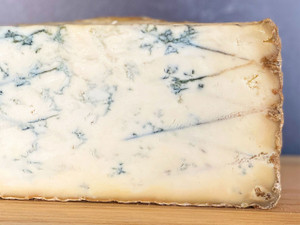Description
This isn't just any Stilton. This version is made by Richard Rowlett & Billy Kevan at Colston Bassett District Dairy in Nottinghamshire, England. Colston Bassett is one of the smallest Stilton dairies in the UK. They have been making Stilton the old-fashioned way for over 100 years. They source their milk only from five neighboring farms and that attention to detail and quality shows through in the finished product.
This 'King of Blues' was invented by Elizabeth Scarbrow and first served in 1720 at the Bell Inn in Stilton, England. It is made using pasteurized cow's milk and traditional animal rennet. The curd is hand-ladled before draining, which results in a luscious, creamy texture. The rinds are dimpled and aged, bearing the marks of the 3-4 months it spends in the caves.
The distinctive blue veins become more defined as the cheese matures, all the while maintaining a luxurious, silky texture and a long, fruity bite.
INGREDIENTS: Cow's milk, salt, rennet, cultures, Penicillium Roqueforti.
More Information
- Country of Origin
- England
- Region
- Nottinghamshire
- Type of Milk
- Cow
- Milk Treatment
- Pasteurized
- Rennet
- Animal
- Cheese Style
- Blue
- Allergens
- Milk
Colston Bassett Dairy
Caring for Your Cheese
How much cheese should I buy?
We advise buying small quantities more frequently to avoid long term storage because the complex flavors and aromas of good cheese will change and degrade over time. For appetizer quantities and not much left over, we suggest 1/4 lb per person. For larger servings or if you'd like some left overs, we suggest a full 1/2 lb per person.
How should I serve my cheese?
You can serve any number of cheeses: a single magnificent chèvre or a large selection celebrating the diversity of aromas, flavors and textures found in various traditions around the world. Choose what you like and what you expect your audience will enjoy. We usually go for a selection of three to four cheeses with various milk types, textures and flavors.
Take your cheese out of the refrigerator an hour or so before serving. Just before serving, unwrap each cheese and scrape the cut surface with a knife edge to remove a thin layer. If you notice dried out parts or mold on the face of the cheese, cut it away.
Can I eat the rind?
Most cheeses have rinds and most rinds are edible. If you don’t like the taste or texture, cut it off.
What do I do about the mold on my cheese?
Cheese stored for some time may grow exterior molds. Typical molds will be white or blue-green but you can sometimes come across yellow or gray. Most of the time, you can refresh the cheese by cutting away those affected areas. The cheese underneath will be fine.
How do I store my cheese?
Store in a higher humidity area of your refrigerator - likely an enclosed spot which allows for limited airflow rather than constant drafts.
How do I wrap my cheese?
Use a clean wrap of the cheese paper, or, in a pinch use parchment (for softer cheeses) or aluminum foil (for firm to hard cheeses).
Enjoy!
No reviews yet.
Click the button below and be the first to review Stilton (Colston Bassett English Blue Cow's Milk Cheese)











